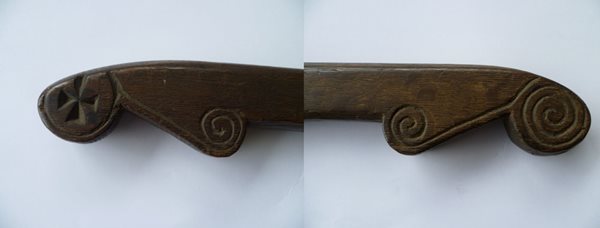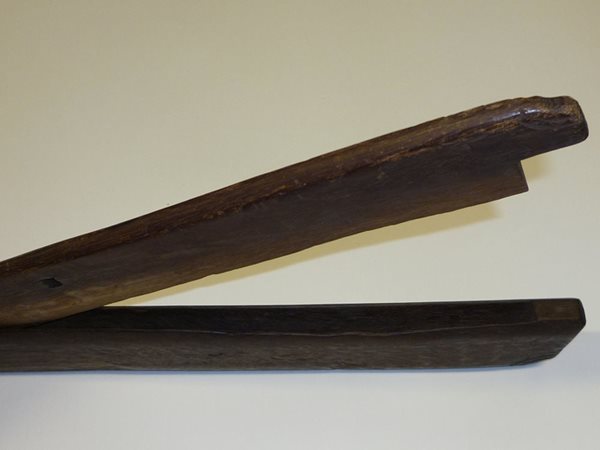c.1850
Flax Clove
A 19th century Flax Clove, known in Irish as a Tlú Lín.
Description
This wooden flax clove from Beara, County Cork consists of two sections. The larger of the two consists of a handle and a deeper part the upper edge of which has a deep rectangular groove. The second section is a chopper hinged at one end by a wooden peg and which works up and down in the groove. When both sections are closed, the flax clove measures 59.5cm long, 9cm high and 2.5cm wide. The handle bears two ornamental finishes at the end. Both sections are also decorated with parallel curved grooves which are described as being amateurish but confident.
What was a flax clove used for?
Flax cloves were used for breaking and scutching flax on a scale for domestic use. Breaking shatters the hard but brittle inner core of the flax plant, releasing the outer fibers which will become linen while scutching separates the woody stem from the flax fibres. When the flax clove was in use, retted flax was held transversely across the channel and drawn across it while the blade was chopped up and down on it to break it. Retting assists in removing the agents that bind the fibers to the stalk.

When the breaking was completed the blade was held pressed down firmly on the flax with one hand while with the other the flax was drawn sharply under the edges thus removing the boon (woody portion of flax).
Ireland’s nineteenth century linen industry
The Irish linen industry was at its peak in the late eighteenth and early nineteenth century. However, the lucrative trade did not disappear after that time. By the mid-1800s the flax industry in Cork, Limerick, Tipperary and Galway city was enjoying a prosperous revival. This spurred other towns to try and emulate this success. A revival of the linen trade in Castlebar, County Mayo saw acreage under the flax crop increase threefold and a Flax Spinning Company was established to manage the industry from the sowing of flax to the selling of the final linen product. The popularity of cotton and later man made synthetic fibres dealt blows to the linen industry but linen retained a niche within the market which it has retained.

Learn More
This specimen is stored in the Museum’s reserve collection in Turlough Park and is not on public display. However, there are many examples of objects related to linen manufacture on public display at Turlough Park.
Location:
Flax Clove is located at:
In Storage
Previous artefact:
Next artefact:
Gaelic Athletic Association Football Rules Book 1888
